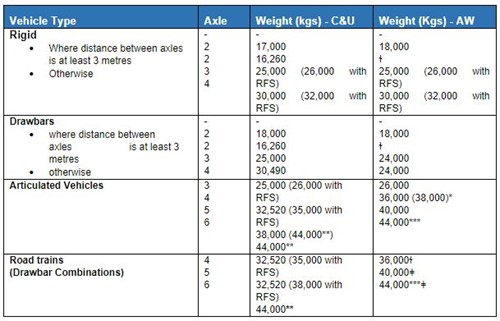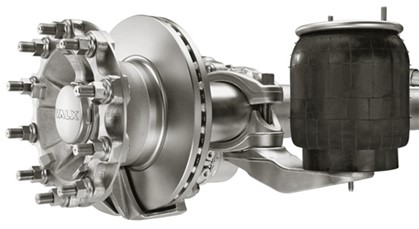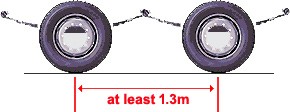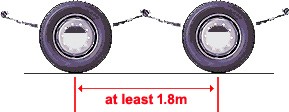Vehicle Axles
The maximum permissible weights and dimensions of goods vehicles in the UK have traditionally been set out in the Road Vehicles (Construction and Use) Regulations 1986. However, EU legislation in the form of directives has been incorporated into these regulations. Directive 85/3 set common weights and dimensions standards for vehicles used in International transport. Directive 96/53 superseded the earlier directive and applied the weights standards to domestic transport.
On 1 January 1999 directive 96/53 regarding weight limits was made law as part of the Road Vehicles (Authorised Weight) Regulations 1998 and was not included within the Construction and Use Regulations as a further amendment.
The Authorised Weight Regulations run in parallel with C&U Regs, operators may choose to comply with either set of regulations. However, you cannot comply with a combination of the two regulations.
Vehicle Axles
- Vehicle weights
- 44 tonnes in operation
- Axle Weight Limits
- Bogie Weights - C&U
- Bogie Weights - AW (Authorised Weights)
- Weight by reference to axle spacing
Vehicle Weights
The information laid out in the tables below shows both Construction and Use (C&U) and Authorised Weight (AW) rules. However, please be aware, it is not possible to operate to the weight limits in the AW regulations whilst using the axle spacing’s specified in the C&U regulations.

| RFS means that road-friendly suspension is fitted on the drive axle. As an alternative each drive axle weight may not exceed 9,500kg (but see ** and *** below). Twin tyres must also be fitted. |
| * 38,000kg is permitted where the combination consists of a two-axle tractor unit and a two-axle semi-trailer, the weight of the tractor unit does not exceed 18,000kg, the weight of the semi-trailer does not exceed 20,000kg for which an axle spacing of at least 1.8m is required and drive axle is fitted with twin tyres and road-friendly suspension. |
| ** Operation over 38,000kg is restricted to certain road-rail movements, subject to conditions - see below. |
| *** Operation over 40,000kg requires the axle weight of each drive axle not to exceed 10,500kg, the drive axle(s) to have road-friendly suspension or not to exceed 8,500kg axle weight, the trailer to have road-friendly suspension and each part of the vehicle combination to have three axles. (Operation over 41,000kg requires, also, the use of an engine complying with the Euro II standard (or better) or a gas engine.) |
| ǂ The distance between the rear axle of the motor vehicle and the front axle of the trailer must not be less than 3 metres. |
| ɫ See section “weight by reference to axle spacing” |
Weight by reference to axle spacing – AW Regs
Many tables detail the regulatory requirements within the C&U Regs, to simplify matters, the Department for Transport (Dft), introduced a simple calculation as shown in the table below.
By using this calculation, it is now straightforward to calculate the weight at which a vehicle will be allowed to operate under the authorised weight regulations. It must be noted, however, that the factor will vary according to the number of axles, as follows:
- Rigid Vehicles - the distance between the front and rear axles (metres) multiplied by the factor in the table which applies to the number of axles;
- Articulated vehicles - the distance between the semi-trailer kingpin and the centre line of the rearmost axle (metres) multiplied by the factor in the table which applies to the number of axles
The calculated figure should be rounded up to the nearest 10kg if the resultant calculated number is less than the maximum authorised weight.
The maximum allowable weight in the UK is now the lower of the maximum authorised weight as defined in the regulations and that is determined by applying the multiplier to the vehicle wheelbase. Therefore if the calculated figure is less than the maximum authorised weight in the UK then the vehicle is restricted to this lower figure. If this figure is greater than the maximum authorised weight in the UK, the vehicle may only operate at the maximum authorised weight in the UK. (See the factor to be used in the calculation as shown below.)
|
Vehicle |
Factor |
|
4 axle rigid 3 or more axle trailer which is not a semi-trailer or a centre axle trailer |
5,000 |
|
3 axle rigid Articulated vehicle |
5,500 |
|
2 axle rigid |
6,000 |
Examples:
- A two-axle rigid motor vehicle with a 2.5-metre axle spread would be limited to 2.5 x 6,000 = 15,000kg.
- A four-axle rigid motor vehicle with a 6.5-metre axle spread would be limited to 6.5 x 5,000 = 32,500kg which is above the maximum authorised weight. The maximum authorised weight of 32,000kg therefore applies.
- An articulated vehicle with a distance of 7.28 metres between the kingpin and the centre line of the rearmost axle would be limited to 7.28 x 5,500 = 40,040kg. ie, the maximum authorised weight of 40,000kg applies if part of a five-axle vehicle (and not operating on an international road/rail movement with a 40ft ISO container).
44-tonne operation
The current normal maximum weight for a goods vehicle is 44 tonnes. This has been the case since the regulations changed on 1 February 2001. Some conditions have to be met for this weight to be permitted.
- The vehicle and trailer must each have at least 3 x axles
- The trailer must have Road-Friendly Suspension
- The vehicle's drive axles to have Road-Friendly Suspension
- The engine must conform to at least Euro II standard
- The axle weight of each axle must not exceed 10,500 kgs
With effect from 1 January 1999, 5 axle combinations can operate at 44 tonnes only if the vehicle is carrying a 40 ft. ISO container as part of an International and multi-modal (road and rail) journey. The driver must have documents to prove this throughout the journey.
An earlier regulation allowed 44 tonnes on six axles only from March 1994. The rules are quite prescriptive and require an ISO container on a multi-modal journey or ‘piggyback’ road/rail semi-trailer, no goods added or removed during the journey and documentation detailing the movement of the goods and the railhead being used. There are also restrictions on the type and weight of the axle.
Axle Weight Limits
The following table lays out the axle weight limits by Construction & Use and Authorised Weight limits.
|
Axle Type
|
Weight (kg) C&U |
Weight (Kg) AW |
|
|
One Wheeled Axle a. Fitted with a wide tyre (width of not less than 300mm). Or fitted with twin tyres at least 300mm apart. |
|
5,090 |
|
|
b. Otherwise |
4,600 |
|
|
|
Two Wheeled Axle a. Single tyre wheels |
 |
9,200 | 10,000 |
|
b. Twin tyres or wide tyres |
|
10,170** |
10,000 |
|
c. as above where the axle is the sole driving axle of a motor vehicle |
|
10,500** |
11,500 |
|
Axle Type
|
Weight (kg) C&U |
Weight (Kg) AW |
|
Three Wheeled Axle with more than two wheels in line transversely:
Otherwise
|
10,170
- 11,180 10,170 |
|
|
** Twin tyres must have the centres of their areas of contact with the road at least 300mm apart. Wide tyres must be at least 300mm wide. |
||

Image reproduced with kind permission of VALX
Bogie Weights - C&U (Two closely spaced axles (see Fig 1. and Fig 2. below))
The weight that two "closely spaced" axles (two axles spaced at least 1.02 metres but not more than 2.5 metres apart) on a motor vehicle, drawbar trailer or semi-trailer, may impose on the road depends on two factors:
- The distance that the two axles are apart; and
- The relevant plated weight of each axle
The regulations provide a scale-dependent on these distances and plated weights.
|
Fig 1. - Motor Vehicles
|
Total maximum weight = 19,000kg provided every driving axle is fitted with twin tyres and either every driving axle has road-friendly suspension (RFS) or neither of the axles has an axle weight exceeding 9,500kg. |
|
Fig 2. - Trailers
|
Total maximum weight = 20,000kg. |
Three closely-spaced axles (see Fig 3. and Fig 4. below)
The weight that three "closely spaced" axles (where the outermost axles are spaced not more than 3.25 metres apart; and no axle has a plated weight exceeding 7,500kg mpw) on a motor vehicle, drawbar trailer or semi-trailer may impose varies depending upon the axle spacing between any adjoining axles.
When X or Y are both at least 1.3m in length any, or each, of the axles, may be plated at 7,500kg mgw.
|
Outer axle spread 3.25m Maximum plated weight for any axle = 7,500kg Maximum total weight = 22,500kg |
Fig 3.
|
Three axle semi-trailer are permitted to have each axle plated at 8,000kg, and the total weight of a tri-axle semi-trailer may be plated at 24,000kg, provided the following conditions are met:
- Each axle must be fitted with air or fluid suspension devices (meeting set conditions)
- The distance between any two adjoining axles must be at least 1.3 metres
|
(Tri-axle semi-trailers meeting these conditions). Outer axle spread - maximum of 3.25 metres. Maximum plated weight for any axle = 8,000kg. Maximum total weight = 24,000kg. |
Fig 4.
|
Bogie Weights – AW
The requirements were simplified with the introduction of the Road Vehicles (Authorised Weight) Regulations 1998. The changes came into effect from 1 January 1999.
|
Description of Axle |
Axle spacing |
Maximum Authorised Weight (Kg) |
|
Driving tandem axle |
Less than 1 metre. Greater than or equal to 1m but less than 1.3m. |
11,500 |
|
*The driving axle must be fitted with twin tyres and Road-Friendly Suspension, or each driving axle fitted with twin tyres and no axle with an axle weight exceeding 9,500kg. |
||
|
Non-driving tandem axle |
Less than 1 metre. |
11,000 |
|
Tri-axle |
Less than or equal to 1.3m |
21,000 |
The following links provide guidance and further information
The Road Vehicles (Authorised Weight) Regulations 1998
https://www.legislation.gov.uk/uksi/1998/3111/contents/made
The Road Vehicles (Construction and Use) Regulations 1986
https://www.legislation.gov.uk/uksi/1986/1078/contents/made






